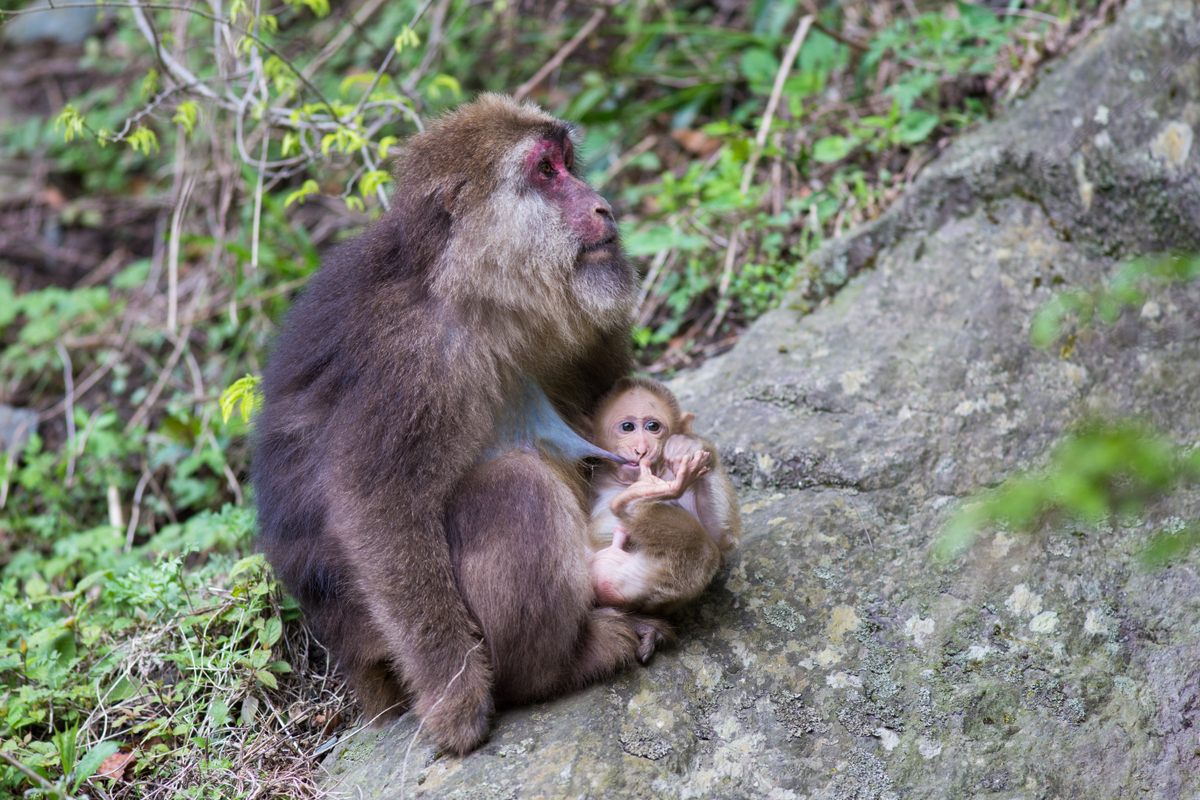In Tibetan Macaques, Females Rule the Roost
In matters of grooming and moving, these primates defer to the ladies.
Reprinted with permission from The Well-Connected Animal Social Networks and the Wondrous Complexity of Animal Societies by Lee Alan Dugatkin, published by the University of Chicago Press. © 2024 by Lee Alan Dugatkin. All rights reserved.
The Huangshan mountains were named by Tang Dynasty Emperor Xuanzong almost 13 centuries ago, in 747, the same year that legend has it the elixir of immortality was found somewhere among its dozens of imposing peaks. Soon hermits, poets, and artists came to Huangshan. Sixty-four temples, many for meditation, were built on the mountain during the Yuan Dynasty between 1271 and 1368; 20 of those temples still exist today.
Many centuries later, the Shanshui (mountain and water) school of landscape painting was born there. Today, the Mount Huangshan Biosphere Reserve, about 370 miles (or 600 kilometers) southeast of Beijing, is a UNESCO World Heritage Site and is home to more than 2,000 species of plants and 417 different species of vertebrates, including clouded leopards (Neofelis nebulosa), Oriental storks (Ciconia boyciana), and Tibetan macaques (Macaca thibetana).
The Tibetan macaques live in an area of the mountain range called the Valley of the Wild Monkeys. There they move about in deciduous and evergreen forests, where they feed primarily on bamboo, grass, fruits, and tubers, although they can, and do, eat bark when other food is scarce. During the summer they spend the nights in trees, where danger from venomous snakes is minimal, while in the winter they prefer huddling together on the ledges of rocky cliffs.
Tibetan macaques can live to age 30, and they spend much of that time involved in some sort of social interaction: Thirty-three different social behaviors—including play, grooming, embracing, and teeth chattering—have been documented in the populations of the Valley of the Wild Monkeys.

In 1986, Jin-Hua Li and Qishan Wang began studying the Yulingkeng (YA1) population of monkeys in this valley. Over the subsequent decades, Dong-Po Xia, Amanda Rowe, Gregory Fratellone, and more than 150 researchers and students from China, Japan, the United States, Australia, England, and Germany have studied anything and everything Tibetan macaque.
By the time Dong-Po Xia joined the macaque research squad in the early 2000s, there was a field station with cabins where he could stay, and the Tibetan macaques were long since used to having humans poking around. Part of that was due to tourism in the reserve, but more to the point, the macaques were (and are) provisioned four times a day by rangers at sites far away from where Xia and others work.
The YA troop lived just a few minutes’ walk from Xia’s cabin, and each morning at about 6 a.m., armed with paper, pencil, and digital tape recorder, he would head out to study 24 macaques in that troop. Xia could recognize individuals based on their natural characteristics and is quick to note that “we get the behavior data in the forest, not in the provisioned area.” He gathered that data until about 6 p.m., when he’d follow the troop to their sleeping site for the night so that the next morning he’d know where to find them.
Xia’s dissertation work focused on social grooming networks in the YA troop. He was especially keen on using network analysis to study grooming relationships among females.
In Tibetan macaques, when males reach sexual maturity at age six or seven, they disperse from their natal group and join, or try to join, another group. Females live their entire lives in the group in which they were born. This has two effects that might be important in social grooming networks. For one, adult females in a group have more experience with one another than do adult males, and for another, adult females in a group are often genetically related to one another, but that is rarely the case for adult males. Because female sociality lies at the heart of life in groups of Tibetan macaques, Xia and his colleagues predicted that adult females would have higher centrality scores—more friends and friends of friends—than adult males in grooming networks and that females would form cliques within grooming networks.

Between May 2009 and August 2010, Xia spent 13 months living in the reserve, each day going out to the forest and gathering data on grooming relationships. He’d select an animal, and then for the next 20 minutes, while standing about 23 feet away from the monkey of interest, he’d take notes on whether it groomed another YA troop member and whether others groomed it.
When the data from the 760 hours of such observations were plugged into a social network model (a tool used to test hypotheses about, in this case, macaque relationships), adult females did indeed have centrality measures that were greater than those of adult males. Xia’s analysis also found five cliques and, with the sole exception of a single adult male in one clique, all clique members were adult females.
Xia’s interest in Tibetan macaque social networks led him to join another project, this one headed by Amanda Rowe, who was conducting a study on travel networks in the YA troop. That work focused on leaders and followers, the latter of whom Rowe refers to as “fans.” Perched on platforms that allowed them to look down on the troop and track movement, Rowe, Xia, and their colleagues set to work.
They defined an act of leadership as a monkey moving at least 30 feet from its otherwise stationary group, with two or more other macaques (known as fans or followers) joining it within five minutes. Network analysis found that dominant females were leaders, and so had more fans than other macaques.
Gregory Fratellone wanted to know even more about macaque travel networks and how they are tied to grooming networks in the Valley of the Wild Monkeys. As part of his master’s thesis, he, along with his colleagues, thought to combine information on centrality in grooming networks with the speed at which travel groups coalesced for a bout of exploration.
What they found was that there were four YA travel cliques in the Valley of the Wild Monkeys. Cliques varied in size, as well as in sex ratio. Not surprisingly, it took smaller cliques less time to come together to prepare for exploration than it did larger cliques.
And, as with almost all things Tibetan macaque, female sociality reigned supreme. When Fratellone’s team looked at the time it took a travel clique to jell as a function of the sex ratio in a clique, they found that cliques with a greater proportion of females were in place and ready to explore more quickly.
Part of the reason females are especially adept at coalescing into travel cliques quickly is that they were well connected via the grooming network, so that they knew each other well and had built up bonds of trust. Still, there’s likely more to it than just that.
Other work in the YA troops has found that dominant males sometimes redirect their anger at each other towards infants. Mothers need to be ready to leave quickly and explore new options when that happens, and when they do, it may be with their female kin, who also have a genetic stake in the welfare of their relative’s infant.















Follow us on Twitter to get the latest on the world's hidden wonders.
Like us on Facebook to get the latest on the world's hidden wonders.
Follow us on Twitter Like us on Facebook